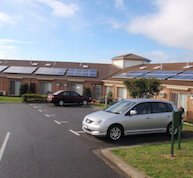A future where Australia’s power needs are met by renewable energy sources will demand substantial alterations to the way that electricity is generated and distributed. This point was recently highlighted in an editorial in the Sydney Morning Herald by Matthew Wright, executive director of Melbourne-based thinktank Beyond Zero Emissions, who described how rooftop solar power could actually be a benefit to the electricity grid and, ultimately, the average electricity user.
Solar power’s place on the electrical grid
Residential solar PV system incentive policies have been given a bad rap, especially in NSW, where an overly ambitious Solar Bonus Feed-in Tariff Scheme and the drama surrounding its hasty and badly-planned implementation have left a bad taste in the mouths of many. However, as Solar Choice has pointed out previously, poor policy-making does not reflect the viability of the technology itself (which does have a good reputation amongst Australians). There are numerous examples of Solar Feed-in Tariffs being implemented effectively throughout the world–most notably in Germany, where a scaled and measured approach to subsidisation has enabled the country to become a solar world leader in spite of its sub-optimal climatic conditions. Solar power can be effectively integrated into the electricity grid, to its benefit.
Distributed generation: Solar PV everywhere
A major benefit of distributed generation such as rooftop PV (as opposed to centralised generation in the form of large-scale generation plants) is the reduction in the costs of peak energy demand. A phenomenon termed the ‘merit order effect‘, recently discussed in a research paper published by the University of Melbourne’s Energy Research Institute, explains how different forms of electricity generation should be prioritised to meet demand. Under the merit order effect, sources with the lowest marginal cost per kWh would be brought online first, followed by more expensive forms of generation. Where solar PV generation is concerned, this means during periods of peak demand–most notably late afternoons in the summer, when home air-conditioning units are at full throttle.
Marginal cost of energy: fossil fuels vs solar power
Such high-demand events have a disproportionate influence on the average cost of electricity–up to 30% of the cost of power as shown on your bill at home is attributable to a handful of these extreme peak periods across the course of a single year. This is primarily due to the fact that, conventionally, the sources of electricity that meet this peak demand, such as gas-fired power plants, have a high marginal cost–as much as $12.50/kWh. This is partly because energy retailers can use their position in the market to charge higher rates to put their plants online when needed most. As Wright comments, “The reason customers were getting an average price under the state (feed-in tariff) programs is because it’s too difficult for ordinary home owners to set up a trading desk and participate in the national electricity market.” Instead, Feed-in Tariffs simplify the matter by setting a flat rate for solar, making it easier for owners of small-scale generators to understand and rely on.
 In addition to the cost of generation, there are also additional infrastructure costs associated with the construction of ‘peak’ plants and maintenance and upgrades of the network infrastructure (‘poles and wires’) required to deliver this power over long distances. In contrast, a Solar Feed-in Tariff guarantees a price for power that, once implemented, does not increase as time goes on; 1kWh of solar energy fed into the grid on a 44c/kWh Solar Feed-in Tariff will never cost more than that.
In addition to the cost of generation, there are also additional infrastructure costs associated with the construction of ‘peak’ plants and maintenance and upgrades of the network infrastructure (‘poles and wires’) required to deliver this power over long distances. In contrast, a Solar Feed-in Tariff guarantees a price for power that, once implemented, does not increase as time goes on; 1kWh of solar energy fed into the grid on a 44c/kWh Solar Feed-in Tariff will never cost more than that.
Solar power: modular generation distributed across the grid
Solar PV systems, once reaching a high level of grid penetration, have the ability to confront the electricity price issue on several fronts: They are a modular, scalable, and proven electricity generation source that can be deployed gradually over time (as opposed to in a one-off investment in a centralised plant); they reduce the need for transmission of electricity over long distances (electricity from solar systems connected to the grid is generally used by homes and buildings nearby); and if connected to the grid on a net feed-in tariff, they reduce overall demand by becoming a home’s primary electricity source (electricity is drawn from the grid only when consumption exceeds production).
Realising the benefits of solar requires vision and willpower
The take-home point made by Wright in his SMH editorial is therefore that, with a bit of holistic vision, drive, and willingness to change the status quo, the Australian state and Federal Governments could protect electricity users against the spectre of rising electricity prices whilst simultaneously smoothing a transition to a clean energy economy. The advantage of a Solar Feed-in Tariff as a policy instrument for achieving these goals is precisely what has given it such a bad reputation in NSW–its cost. While electricity purchased from conventional fossil fuel sources in order to generate 10kWh of energy can cost in the order of $120, an equivalent amount sources from rooftop solar PV on a feed-in tariff rate of, for example, 50c/kWh (lower than NSW’s now defunct scheme but higher than Queensland’s existing one), would cost only $5. According to the University of Melbourne’s findings, the projected savings would be enough to cover cost of the NSW government’s electricity price support scheme for low-income households.
Reaching the level where this benefit could be realised would require rooftop solar PV on a broad scale, however. Although PV prices are reaching all-time lows, attractive Feed-in Tariffs for solar such as those in Queensland, South Australia and Victoria would provide a significant incentive for households to go solar.
© 2011 Solar Choice Pty Ltd
- Solar Power Wagga Wagga, NSW – Compare outputs, returns and installers - 13 March, 2025
- Monocrystalline vs Polycrystalline Solar Panels: Busting Myths - 11 November, 2024
- Solar Hot Water System: Everything You Need to Know - 27 February, 2024
